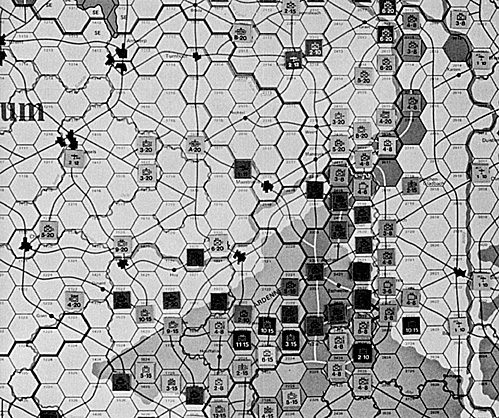Road to the Rhine caught my eye when I first saw it in its original draft incarnation as a pair of Series 120 games. My interest grew as the games changed into a single boxed title, and the attraction of Road to the Rhine was such that it drew even the most jaded of the Workshop staff to playtest sessions. Such dedication was necessary; the skeleton of mechanics fit together rapidly, but the flesh of fine-tuning the systems grew more slowly. From rough draft to finished product, though, the game has proved to be one of the most entertaining and challenging that this boy has played in years.
When the packing crews put this game together, they lovingly fill each box with two maps, two counter sheets, (for a total of 480 counters), a pair of matching CRT/TEC charts, Allied and German OB/OA charts, a twenty-page rule booklet, and the unavoidable page of errata. The physical quality of the components is first-class all the way; the maps and counters, especially, shine with that extra measure of production know-how that says "GDW."
The maps cover eastern France and western Germany along with Belgium, Holland, Luxembourg, and Switzerland at seven miles to the hex, in four colors with over twenty terrain variations. From the sub- sea-level flood plain of western Holland to the High Vosages, and on to the Roer Dams, the geography is thorough, attractive, and readily identifiable.
The counters include one sheet of Allies and one of Germans. The Germans are presented in classic feldgrau, with the SS in standard white on black, the Luftwaffe on light blue and naval troops in white on deep blue. The Allies are equally tasteful variations of olivegreens and browns for US, British, Canadian, French, Polish, Czech, Dutch, and Belgian units. All ground units have standard strength and movement factors with historical designations. There is an additional number of air units (with ground elements) and markers.
The game covers the Allied "Crusade for Europe" from September 1944 to the end of the war. The battle begins as an incredibly fluid pursuit of routed German troops, by Allied forces increasingly crippled by supply difficulties. It is in this milieu that the rules achieve a great measure of accuracy and playability.
Despite the effective air power, airborne transport, sea movement, and weather rules; despite the flavorful treatment of special effects like the Roer Dam, the German threat of flooding western Holland, the mutinous 30th SS Division, and the US-equipped 150th SS Panzer Brigade; despite the well-conceived combat results table with outcomes such as the "escalating exchange" ... despite all this, the movement system is the heart of Road to the Rhine and the real attraction that kept gamers in line for seats at the play-test tables.
It is a remarkable movement system that evolved largely from the Fall of Tobruk rules, one that re-considers the relationships of maneuver, attack, reaction, and counter- attack. This is done in a manner very distinct from simultaneous movement, but in a manner that approaches the same end- result.
Each conventional player-turn is broken down into a theoretically unlimited number of impulses, during which a player may move any units he chooses and conduct attacks with them. After the conventional post- combat advances and retreats, the defending player is allowed to move any troops designated as "reserve"; these reacting units counter-attack enemy units which have already moved. In the same player-turn (according to the time-record, no time has elapsed - these actions are occuring within the same player-turn) this "first player moves/fights, second player moves/fights" sequence is followed.
The limiting factor is that each individual counter may be moved only once per turn. This requires the careful consideration of units by both players. The attacker aims to create a breach and exploit it in following segments, widening and deepening the penetration with each successive wave to movement and combat. The defender strives to release his reserves quickly enough to plug each gap, but slowly enough so that there is always someone left to counter the attacker's final thrusts.
I enjoyed playing Road to the Rhine, and I think many other gamers will enjoy it, too. It is fast-paced and offers an array of strategic options. In these respects, as well as the opening situation, the game is reminiscent of SPI's popular Panzergruppe Guderian (although I'm compelled to add that Road to the Rhine appears substantially more faithful to historical accuracy) ... an exercise in entertainment and education that requires practice to obtain mastery of its tactics and strategy.

Back to Grenadier Number 6 Table of Contents
Back to Grenadier List of Issues
Back to MagWeb Master Magazine List
© Copyright 2001 by Pacific Rim Publishing
This article appears in MagWeb (Magazine Web) on the Internet World Wide Web. Other military history articles and gaming articles are available at http://www.magweb.com